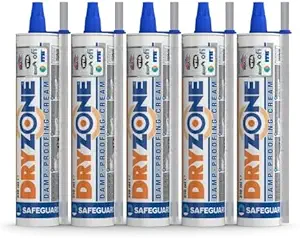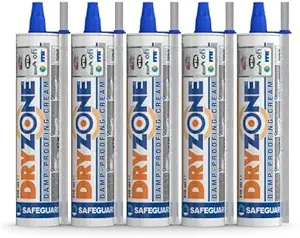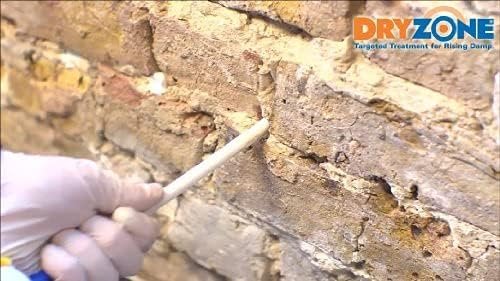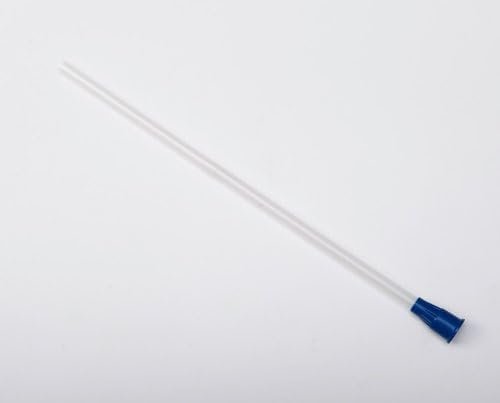Damp Proofing Cream
Damp Proofing Cream: A Comprehensive Guide
Dampness in buildings is a persistent issue that affects the structural integrity and livability of homes and commercial properties. One of the most effective solutions to combat rising damp is the use of damp proofing cream. This article will delve into the concept of damp proofing cream, its application, benefits, and considerations, to provide a comprehensive understanding for those looking to safeguard their property against damp-related problems.

Damp Proofing Cream (DPC) – 310ml x 5 – High-Strength Injection Cream for Rising Damp Treatment – Anti Rising Damp
Introduction
Dampness can lead to significant damage to a building’s structure and interior, including timber decay, mold growth, and compromised insulation. One of the most common causes of dampness is rising damp, where moisture from the ground travels upwards through a building’s walls. To prevent these issues, various damp proofing methods have been developed, with damp proofing cream emerging as a popular and highly effective solution.
Table of Contents
Damp proofing cream is a specialized substance designed to be injected into the walls of buildings to form a barrier against moisture. Unlike traditional methods, such as installing physical damp proof courses, damp proofing cream offers a more accessible and non-invasive solution that is both cost-effective and easy to apply. In this article, we will explore the characteristics, application methods, benefits, and considerations of damp proofing crea.

What is Damp Proofing Cream?
Damp proofing cream is a modern, chemical solution formulated to prevent the ingress of moisture into the walls of a building. It typically contains silicone-based compounds that form a water-repellent barrier once injected into masonry. When the cream is applied to the lower sections of walls, it penetrates the masonry and sets within the pores, creating a waterproof barrier that prevents rising damp from traveling up through the walls.
Damp proofing cream is specifically designed to treat rising damp caused by moisture from the ground, although it can also help prevent other forms of moisture penetration, including lateral damp. The cream’s ability to create an impermeable barrier makes it a superior solution to traditional damp proof courses, especially when dealing with older properties where traditional methods may not be feasible.
Why is Damp Proofing Necessary?

Before diving into the specifics of damp proofing cream, it is important to understand why damp proofing is a crucial aspect of building maintenance. Rising damp occurs when moisture from the ground moves upward through porous building materials, such as brick and mortar. This moisture can reach high enough levels to damage walls, floors, and ceilings.

Dampness can lead to a range of problems, including:
- Structural Damage: Prolonged exposure to moisture can weaken the structural integrity of the building, leading to cracks, crumbling mortar, and timber decay.
- Health Risks: Damp environments encourage mold growth, which can result in respiratory issues and other health problems for the occupants.
- Aesthetic Damage: Damp walls can cause unsightly stains, peeling paint, and damaged wallpaper, lowering the aesthetic value of a property.
Damp proofing is therefore vital for protecting both the structural stability of a property and the health of its inhabitants.
How Does Damp Proofing Cream Work?
Damp proofing cram works by creating a chemical barrier in the walls that prevents water from rising. The process is simple yet effective:
- Injection Process: The cream is injected into small holes drilled at the base of the affected walls, typically about 6 inches (15 cm) above the ground level. The cream then soaks into the masonry, filling the pores.
- Reaction with Wall Materials: Once the cream has been injected, it chemically reacts with the materials in the wall, forming a waterproof barrier that prevents moisture from moving upward.
- Curing Time: The cream gradually hardens over time, setting into place and ensuring a permanent moisture barrier. This process takes approximately 2-3 weeks to fully set, but the wall will begin to show signs of improved dryness soon after application.
- Long-Term Effectiveness: The barrier created by damp proofing cream is designed to last for many years, with some manufacturers offering guarantees of 20 years or more. The cream is effective even in conditions of high groundwater moisture and can be used in both residential and commercial properties.
Benefits of Damp Proofing Cream
- Ease of Application: One of the main advantages of damp proofing cream is the ease with which it can be applied. The injection process is relatively quick and non-intrusive, meaning it can be done without major disruption to the building’s interior.
- Cost-Effective: Compared to traditional damp proofing methods, such as installing a physical damp proof course or replacing affected bricks, damp proofing cream is a more affordable solution. It requires less labor and fewer materials, making it a great choice for homeowners looking for a cost-effective way to prevent rising damp.
- Non-Destructive: Damp proofing cream does not require the removal of existing walls or flooring, making it ideal for preserving the aesthetic integrity of older buildings. It also means minimal mess and disruption during the application process.
- Durability: Once applied, damp proofing cream can last for decades, providing long-term protection against rising damp. Most products come with warranties to assure the longevity of the treatment.
- Prevents Mold and Mildew: By stopping moisture from rising through the walls, damp proofing cream helps to prevent the conditions that lead to mold and mildew growth. This improves the overall indoor air quality and reduces the risk of health problems for the occupants.
Considerations When Using Damp Proofing Cream
While damp proofing cream offers numerous advantages, there are some factors to consider before choosing this method:
- Effectiveness for Severe Cases: While damp proofing cream is highly effective in many cases, it may not be the best solution for severe cases of rising damp or where the damage is already extensive. In such cases, a more comprehensive approach, including structural repairs or the installation of a physical damp proof course, may be necessary.
- Pre-Application Preparation: For the cream to work effectively, the wall surface must be clean and free from any loose debris or efflorescence. In some cases, it may be necessary to remove existing plaster or wallpaper before applying the cream. A professional assessment can help determine the best preparation method.
- External Drainage: Damp proofing cream will only address rising damp that originates from the ground; it does not address issues like poor external drainage or leaks in the building’s exterior. It is important to ensure that the property has proper drainage to prevent water from accumulating near the base of the walls.
Conclusion
Damp proofing cream is a highly effective and modern solution for tackling rising damp in buildings. Its ease of application, cost-effectiveness, and long-lasting protection make it a popular choice for homeowners and property managers looking to protect their properties from the damaging effects of dampness. While there are some considerations to keep in mind, such as preparation and the extent of the damp problem, damp proofing cream remains one of the most accessible and efficient ways to safeguard a building against moisture-related issues.
For those dealing with rising damp, damp proofing cream offers a reliable, non-invasive, and durable solution to ensure a dry, healthy, and structurally sound environment for years to come.